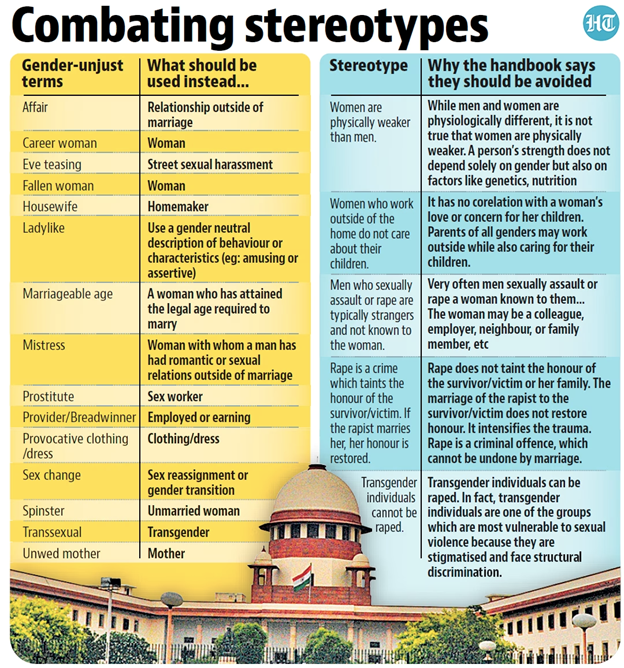Gender Stereotype
Relevance
- GS Paper 1 Role of Women, Social Empowerment, Issues Related to Women.
- Tags: #GenderStereotype #WomenStereotype #HandbookonCombatingGenderStereotypes.
Why in the news?
- The Supreme Court of India has taken a significant step to challenge outdated ideas, especially those affecting women, by releasing a special guide.
- This guide introduces new words for lawyers and judges to use in court, aiming to fight harmful beliefs.
Handbook on Combating Gender Stereotypes
- The handbook provides a list of biased words and suggests better alternatives for legal documents.
- Its main aim is to provide legal experts with the means to “identify, understand, and challenge stereotypes about women.”
- It includes a list of terms that promote gender bias and offers alternative, fairer terms to be used in legal documents.
Objective and Scope of the Handbook
- Challenging Old Beliefs: The Supreme Court’s initiative aims to discard old-fashioned and harmful stereotypes, particularly those related to women, through the ‘Handbook on Combating Gender Stereotypes.’
- CJI’s Vision: The handbook is introduced by Chief Justice D.Y. Chandrachud, who explains its purpose: to help legal professionals recognize and counter gender-based stereotypes.
- Language Transformation: The handbook includes a glossary of terms that contribute to gender bias and suggests better alternatives to be used in legal writings.
Why such a move?
[A] Language inflicting Stereotypes
- The handbook points out terms in legal language that promote gender bias and provides suggestions for change.
- Examples of Change: Instead of using “adulteress,” the handbook recommends using “Woman who has engaged in sexual relations outside of marriage” to avoid disrespectful language.
- Removing Biases: The handbook encourages using simple terms like “woman” and “wife” instead of prefixes like “chaste” or “obedient.”
- Using Neutral Language: Instead of negatively using “effeminate,” the handbook suggests using neutral terms like “confident” or “responsible.”
[B] Avoiding labelling
- Empowering Language: The handbook suggests using “survivor” or “victim” to describe individuals affected by sexual violence.
- Respecting Preferences: The choice between “survivor” and “victim” should be based on the individual’s preference.
[C] Conscious Reporting of Cases
- Separating Attire and Consent: The handbook emphasizes that a person’s clothing should never excuse unwanted touching; consent remains essential.
- Breaking Stereotypes: The handbook rejects the idea that delayed reporting of sexual assault means it didn’t happen.
- Encouraging Reporting: The handbook acknowledges the bravery required to report sexual offenses due to societal pressures.
Negative Effects of Gender Stereotypes
- Widespread Impact: Gender stereotypes lead to exclusion and prejudice in workplaces, schools, and public places.
- Education Example: The handbook illustrates how stereotypes affect students from marginalized communities, adding stress during exams.
- Government Data: Minister Subhas Sarkar’s data on dropout rates among marginalized students is shared as an example.
Legal reforms rebutting Gender Stereotypes
- Cases for Equality: The Supreme Court points out cases that reject stereotypes, like Joseph Shine vs. Union of India, which struck down the “adultery” law.
- Example Rulings: The court’s decisions in cases like the State of Jharkhand vs. Shailendra Kumar Rai and the State of Punjab vs. Gurmit Singh are explained.
Conclusion
- By offering alternatives to outdated and biased language, the handbook aims not only to reshape legal discussions but also societal viewpoints.
- Its potential impact is anticipated to extend beyond legal matters, influencing everyday perspectives and contributing to a more equitable society.
Source: Live Mint
Mains Question
What is gender stereotyping? Discuss its implications on women in Indian society.




